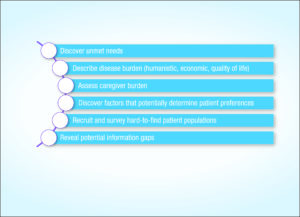SPRING 2019, THE EVIDENCE FORUM, WHITE PAPER
 Evie Merinopoulou, MSc Senior Research Associate Real-World Evidence Evidera |  Andrew Cox, PhD Research Scientist Real-World Evidence Evidera |
Rare Diseases, Drug Development, Decision-Making, and the Patient Perspective
Rare diseases pose several challenges to the drug-development process. Since patients who suffer from rare diseases are infrequent and geographically dispersed, important medical and clinical information is often highly limited and difficult to locate. Furthermore, for many rare diseases there is not a high level of awareness among the medical community in general, and that can lead to misdiagnoses, extended pathways to correct diagnoses, and a lack of appropriate medical codes with which to identify the patients correctly. All these factors conspire to make it more difficult to understand the natural history, epidemiology, and progression of diseases that affect small and often highly diverse patient populations.
Understanding the patterns of healthcare, burden, and unmet needs of rare disease patients is equally difficult and frequently an almost impossible task. The challenge of identifying rare disease patients also makes it more difficult to conduct studies aimed at discovering their perspectives and needs. In recent years there has been a profound shift to a more patient-centric, drug-development process to ensure the patient voice is incorporated across all stages. This is particularly true for rare diseases, where incorporating the patient voice into orphan drug development is a priority.
In January 2019, the US Food and Drug Administration (FDA) published a revised draft guidance on rare and orphan drug development. The guidance encourages researchers to involve patients, caregivers, and advocates, having them provide input on their experiences, perspectives, and priorities related to potential endpoints used during the drug-development process and regulatory review.1 The guidance also encourages the use of social media as a means to represent the perspective of the patients. Additionally, an increasing number of manufacturers are involving patient representatives in early trial design to understand whether trial protocols are acceptable from the patient perspective.2
The Increase in Use of Healthcare-Specific Social Media Platforms
Due to the low prevalence of rare conditions, patients and caregivers are geographically dispersed and may feel isolated, finding it difficult to speak with other patients and specialists about their condition. The need to connect and find support, especially across rare disease communities, has led to an increasing number of patients and caregivers turning to social media platforms for valuable insights on their disease.3 Available healthcare-specific platforms include social networks that focus on rare disease communities, such as RareConnect,4 created by EURORDIS5; rare disease discussion groups supported by closed-access online communities, such as Inspire6 and Smart Patients7; Facebook groups; and, publicly accessible, disease-specific discussion boards. In these platforms, patients can share experiences and important information and offer support and advice. Patients frequently use these sites to share their entire experience with the disease, including side effects, treatments received, pre-diagnosis history, and outcomes. Some forums have posts dated from a decade ago or longer. This information is an important window into the perspective of patients with rare diseases, and in many cases, this is the only way to learn about patient experience.
Researchers have recognized the potential of these social media platforms in aiding orphan drug research and development. In a recent study8 for a very rare paediatric condition, researchers recruited and surveyed the largest reported contemporary cohort of 671 people born with a single functional ventricle in their hearts by using Facebook, Twitter, and other social media platforms. Existing historical conversations on healthcare-specific social media can be used to support a wide range of research questions (See Figure 1).
Figure 1. Potential Uses of Social Media Data in Rare Diseases
How Can Healthcare-Specific Social Media Help?
Our experience shows that traditional approaches to evidence generation for many rare diseases rapidly reach a dead end due to a lack of appropriate medical codes and data sources, and the difficulty in reaching patients. To remedy this, creative approaches need to be adopted. With limited quantitative data available in health databases, contextual information gained through social media sources should be considered. Analysis of social media for rare diseases can provide a cost-effective means of illuminating the unmet needs, disease burden, opinions, treatments, side effects, and potential misdiagnoses of patients. Such information can also be used to better design patient questionnaires and patient preference studies.
Another way social media forums can be used to better understand the patient perspective is to rely on the close-knit and connected nature of the rare disease community to participate in an online patient questionnaire study. Providing a secure patient questionnaire through social media allows patients in the community to share the link, creating a kind of snowball recruitment that can be highly effective.8
Previous studies have compared the use of patient social media forums with the more traditional patient survey approach as a source of data for qualitative research aimed at capturing the patient experience.9,10 The two studies referenced as examples both found that searching social media to capture patients’ perspectives on the impacts of a disease is a feasible and fruitful approach. Social media searches may be useful as a preliminary step in research (e.g., for informing the development of discussion guides), and for supplementing the results of traditional qualitative approaches. The studies found both approaches highlighted common themes, with substantial overlap in the results; unique information was gathered in each approach, suggesting that they may be complementary.
A distinct advantage of social media is its shorter timeline; patient survey studies may take several months to complete and may lack the number of rare disease patients to allow saturation of important concepts to be reached. Studies based on social media can often incorporate many more patients than can be reached in a survey and do not require a complex recruitment and interview process. One area of uncertainty for social media is the extent of potential bias in using this data source. While the potential biases in questionnaire-based studies are well documented11 (one study catalogued 48 potential bias types), the use of social media as a qualitative data source is relatively new and the potential for bias is still being explored. However, social media studies can draw on larger sample sizes, which helps ensure that all common concepts are captured (saturation). Social media posts are unsolicited and not responses to specific questions, making them less prone to bias types introduced by the structure and design, as well as the interviewers, in a more traditional questionnaire-based study. Combining both study types would be the best approach to ensure more reliable and more in-depth insights into patient perspective.
Case Studies: Using Social Media to Understand Patient Experience of Acute Myeloid Leukaemia
Myelodysplastic syndromes (MDS) constitute a rare group of hematopoietic stem-cell disorders12 that predominantly affect elderly patients.13 According to a systematic literature review published in 2016, the global prevalence of MDS ranged from 0.22-13.2 per 100,000 people across all ages, genders, and ethnicities.12 However, the actual prevalence of MDS is hard to estimate due to underreporting of MDS in cancer registries, and under-diagnosis of MDS in older patients14 with cytopenias, particularly anaemias due to MDS.
Approximately one in three patients with MDS can rapidly progress to a life-threatening failure of bone marrow or develop acute myeloid leukaemia (AML).15 The American Cancer Society estimates there will be 21,450 new cases of AML in the US in 2019, mostly in adults,16 accounting for 1% of all new cases of cancer. Despite advancements in the treatment of hematologic malignancies (with the development of effective targeted and immune therapies), the survival rate of patients with AML is poor. Based on data from the Surveillance, Epidemiology, and End Results program (SEER) 2008-2014, the five-year relative survival rate in patients with AML was 27.4%.17 Standard treatment approaches in MDS/AML largely depend on MDS risk and other prognostic factors, including patients’ age and comorbidities, and patients’ goals. More aggressive forms of therapy, such as stem-cell transplantations (SCT) and chemotherapy, are usually reserved for younger and fit patients who are at high risk. For elderly or frail patients who are ineligible for chemotherapy or SCT, supportive care is essential for improving quality of life.18 Given the poor survival rate and significant unmet needs among patients who are ineligible for chemotherapy, it is necessary to understand and incorporate patient and caregiver perspectives and priorities into the development of an optimal care plan.
While traditional research approaches for reaching out to rare disease populations involve surveying patients recruited through disease registries or patient-advocacy groups, social media can offer a different avenue to accessing hard-to-find patient populations.
A growing number of studies have used social media sources to help understand the experiences, burden, preferences, and unmet need for rare disease communities. Kusumgar et al. examined around 7,000 posts from AML patients and caregivers, and the study found that 20 percent of posters were older than 65 years of age, which was somewhat surprisingly high given that social media are more popular in younger ages. Sixty percent of the discussion was conducted by caregivers, who assumed more social media responsibilities when patients relapsed or declined physically.19 This shows that even if patients are unable to participate in social media, their experiences can still be represented by caregivers.
The study also found that patients and caregivers used social media to seek disease information, emotional support, to set treatment and recovery expectations, as well as to compare their experiences with others. The study also suggested a lack of practical patient-focused education and support via online and offline venues.
Two recent studies also utilized social media forum postings to understand the patient experience of AML and MDS.20,21 These studies used 1,443 posts from 220 AML patients to explore the unmet needs and perspectives around treatment choices for those patients who were ineligible for intensive chemotherapy. Research found that the patients encountered a lack of information about treatments, and the condition in general. The studies concluded that clinicians need to ensure these topics are discussed and delivered in a manner that can help patients make more effective treatment decisions. Furthermore, a greater understanding of AML and its symptoms is required to potentially allow for earlier diagnosis.
Summary
Studying healthcare-specific social media forums can support research in rare diseases in many ways, such as helping to find and recruit patients for research studies. Analysing documented conversations can also help to incorporate patient and caregiver perspective into decision making. Social media offers insights comparable to patient surveys and has several advantages, such as reduced timelines to information, alternative perspectives, and analysis of experiences of higher numbers of patients. With much of the discussion and published material for rare diseases too often focused on the medical and scientific perspectives, analysis of social media data can serve the important aim of better representing the patient perspective. Analysis of these data can help to highlight important patient values and help the medical and scientific communities to better communicate with and understand the patients in their care. Furthermore, information gained in this way can help highlight unmet need, which can allow for better development and prioritizing of treatments.
References
- US Food and Drug Administration. Rare Diseases: Common Issues in Drug Development, Guidance for Industry, Draft Guidance. February 2019. Available at: https://www.fda.gov/downloads/Drugs/GuidanceComplianceRegulatoryInformation/Guidances/UCM629579.pdf. Accessed February 21, 2019.
- Milne CP, Ni W. The Use of Social Media in Orphan Drug Development. Clin Ther. 2017 Nov;39(11):2173-2180. doi: 10.1016/j.clinthera.2017.08.016.
- Pew Research Center. Peer-to-Peer Health Care. February 11, 2011. Available at: http://www.pewinternet.org/2011/02/28/peer-to-peer-health-care-2/. Accessed February 22, 2019.
- RareConnect. Available at: https://www.rareconnect.org/en. Accessed February 22, 2019.
- EURORDIS. About EURORDIS. Available at: https://www.eurordis.org/about-eurordis. Accessed February 22, 2019.
- Inspire. Available at: https://www.inspire.com/. Accessed February 22, 2019.
- Smart Patients. Available at: https://www.smartpatients.com/. Accessed February 22, 2019.
- Schumacher KR, Stringer KA, Donohue JE, et al. Social Media Methods for Studying Rare Diseases. Pediatrics. 2014 May;133(5): e1345-1353. doi: 10.1542/peds.2013-2966.
- Jamison J, Sutton S, Mant J, De Simoni A. Online Stroke Forum as Source of Data for Qualitative Research: Insights from a Comparison with Patients’ Interviews. BMJ Open. 2018 Mar 30;8(3): e020133. doi: 10.1136/bmjopen-2017-020133.
- Gelhorn HL, Anand SB, Parvizi J, Morrison T, Yu H, Pokrzywinski R, Al-Jassar G, Cox A, Dashiell-Aje E, Chen AF. Qualitative Interviews versus Social Media Searches: Comparing Two Approaches for Concept Elicitation. Paper presented at: ISPOR 21st Annual International Meeting 2016; Washington, DC.
- Choi BC, Pak AW. A Catalog of Biases in Questionnaires. Prev Chronic Dis. 2005 Jan; 2(1): A13.
- Lubeck DP, Danese M, Jennifer D, Miller K, Richhariya A, Garfin PM. Systematic Literature Review of the Global Incidence and Prevalence of Myelodysplastic Syndrome and Acute Myeloid Leukemia. Blood. 2016;128(22):5930.
- Ma X. Epidemiology of Myelodysplastic Syndromes. Am J Med. 2012 Jul;125(7 Suppl): S2-5. doi: 10.1016/j.amjmed.2012.04.014.
- Cogle CR. Incidence and Burden of the Myelodysplastic Syndromes. Curr Hematol Malig Rep. 2015 Sep;10(3):272-81. doi: 10.1007/s11899-015-0269-y.
- Klepin HD. Myelodysplastic Syndromes and Acute Myeloid Leukemia in the Elderly. Clin Geriatr Med. 2016 Feb;32(1):155-73. doi: 10.1016/j.cger.2015.08.010.
- American Cancer Society. Key Statistics for Acute Myeloid Leukemia (AML). Available at: https://www.cancer.org/cancer/acute-myeloid-leukemia/about/key-statistics.html. Accessed February 22, 2019.
- National Cancer Institute. Cancer Stat Facts: Leukemia – Acute Myeloid Leukemia (AML). Available at: https://seer.cancer.gov/statfacts/html/amyl.html. Accessed February 22, 2019.
- Sanchez JF. Treatment of Myelodysplastic Syndromes in Elderly Patients. Adv Ther. 2011 Mar;28 Suppl 2:1-9. doi: 10.1007/s12325-011-0001-9. Epub 2011 Mar 9.
- Kusumgar S, Johnson K, Belford M, Desai A, He J. Patient-Relevant Experiences and Impacts of Acute Myeloid Leukaemia: Evidence from Online Social Networks-Based Qualitative Research. Blood. 2015;126(23):4523.
- Booth A, Bell TJ, Halhol S, Pan S, Welch VL, Merinopoulou E, Lambrelli D, Cox A. Treatment in AML and MDS Patients Who Are Ineligible for Intensive Chemotherapy: Using Social Media Intelligence to Capture What Really Matters to Patients. Paper presented at: ASH Conference 2018; San Diego, CA.
- Booth A, Bell TJ, Halhol S, Pan S, Welch VL, Merinopoulou E, Lambrelli D, Cox A. Using Social Media to Highlight Unmet Needs in Patients with AML and MDS Ineligible for Intensive Chemotherapy: A Patient Centered Perspective. Paper presented at: ASH Conference 2018; San Diego, CA.
For more information, please contact
[email protected] or [email protected]





